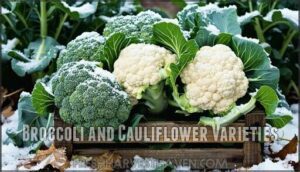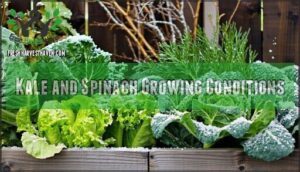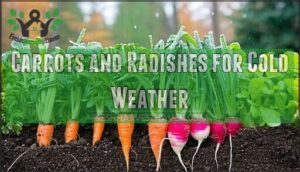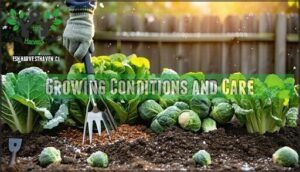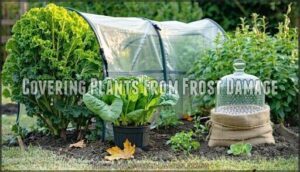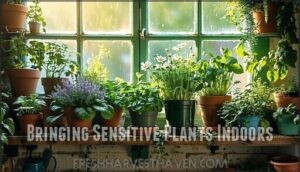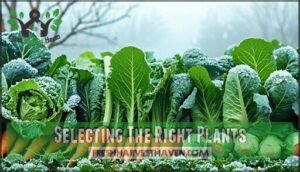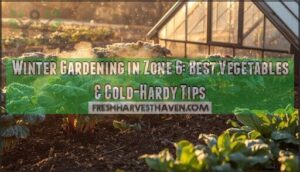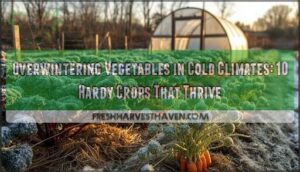This site is supported by our readers. We may earn a commission, at no cost to you, if you purchase through links.
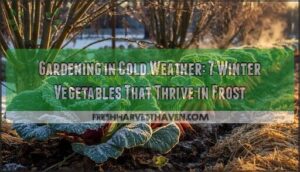
Cold-hardy crops like kale, Brussels sprouts, and carrots actually taste sweeter after frost hits them.
Start by testing your soil in fall and adding compost to boost microbial activity by 40%.
Install winter mulch to insulate roots and reduce temperature swings by 8°F.
Most winter vegetables need 4-6 hours of sunlight daily and well-draining soil to prevent waterlogged roots.
Understanding frost warnings helps you protect plants at the right time – covering them before temperatures drop below 36°F prevents damage.
Winter gardening isn’t just possible, it’s rewarding when you know which varieties thrive in harsh conditions.
Table Of Contents
- Key Takeaways
- Cold Weather Gardening Basics
- Cold Hardy Vegetable Plants
- Growing Conditions and Care
- Frost and Freeze Protection Methods
- Selecting The Right Plants
- Frequently Asked Questions (FAQs)
- Can vegetables grow in cold weather?
- Is cold weather gardening right for You?
- Are cold weather plants hardy?
- Is cold-weather gardening a good idea?
- Do cold-hardy plants survive winter?
- Can carrots grow in cold weather?
- When to plant cold season vegetables?
- Can a vegetable garden survive a frost?
- What temperature is too cold for garden plants?
- What is the gardening 3 year rule?
- Conclusion
Key Takeaways
- You’ll get sweeter vegetables when frost hits cold-hardy crops like kale, Brussels sprouts, and carrots – they convert starches to sugars as natural antifreeze
- You can extend your growing season by preparing soil with compost and winter mulch, which boosts microbial activity by 40% and reduces temperature swings by 8°F
- You’ll need to protect plants before temperatures drop below 36°F using row covers, cold frames, or emergency coverings like bedsheets to prevent damage
- You should choose varieties bred for cold tolerance and plant them 10-12 weeks before your first frost date for successful winter harvests
Cold Weather Gardening Basics
Cold weather gardening isn’t as intimidating as it might seem—many vegetables actually prefer the cooler temperatures and can handle surprising amounts of frost.
You’ll discover that winter gardening requires different strategies than summer growing, from soil preparation to plant selection.
The rewards include sweeter vegetables and fresh produce when grocery store options are limited.
Preparing Soil for Cold Weather
Proper soil preparation sets the foundation for successful cold weather gardening and healthier winter harvests.
Cold soil becomes compacted, reducing oxygen flow and root development by up to 30%.
Winter soil loses 30% of its oxygen flow when compacted—your plants need room to breathe
Here’s how to prep your soil for winter success:
- Conduct soil testing in fall to identify pH imbalances and nutrient deficiencies before cold weather limits plant uptake
- Apply soil amendments like compost and manure, which boost microbial activity by 40% and provide steady nitrogen release
- Install winter mulch using straw or leaves to insulate roots and reduce temperature fluctuations by 8°F.
A reliable testing option can help determine the specific needs of your soil.
Choosing The Right Plants for Cold Weather
Since cold weather gardening success hinges on variety selection, you’ll need hardy plants with proven hardiness ratings for your zone.
Cold hardy vegetables like kale, Brussels sprouts, and carrots actually improve in flavor after frost exposure.
Visit local nurseries for regionally-adapted cold climate crops that understand your microclimate selection needs.
Consider companion planting strategies—pairing frost hardy spinach with protective taller brassicas creates natural wind barriers while maximizing garden space efficiency.
Understanding Frost and Freeze Warnings
When frost threatens your garden, knowing Warning Severity helps you protect vulnerable plants. Local Forecasts provide vital timing for frost protection measures in cold weather gardening.
Temperature Thresholds determine Plant Vulnerability:
- Frost Advisory (33-36°F): Light frost possible, tender plants at risk
- Freeze Warning (28-32°F): Hard frost likely, most annuals won’t survive
- Hard Freeze Warning (below 28°F): Severe damage to most plants
- Killing Freeze (below 24°F): Growing season ends for unprotected plants
Action Timing matters most – cover plants before temperatures drop. Even cold weather veterans with good frost tolerance benefit from protection during severe warnings.
Cold Hardy Vegetable Plants
You’ll discover that certain vegetables actually prefer winter’s chill, developing sweeter flavors and crispier textures when temperatures drop.
These cold-hardy champions can handle frost like seasoned winter athletes, continuing to grow while other plants retreat indoors, making them cold-hardy.
Broccoli and Cauliflower Varieties
Smart broccoli cultivars like ‘Marathon’ and ‘Belstar’ handle multiple frosts while maintaining sweet flavor.
Cauliflower types such as ‘Snowball Y Improved’ develop dense, white curds in cold weather.
Your planting timeline matters—start seeds indoors 6-8 weeks before transplanting for best results.
These vegetable varieties offer excellent pest resistance and superior nutritional value, making winter gardening both rewarding and delicious for your family’s table.
Kale and Spinach Growing Conditions
While broccoli and cauliflower demand careful attention, kale and spinach are your winter garden’s powerhouses.
These cool season crops thrive in soil pH between 6.0-7.0 with consistent moisture—never waterlogged conditions. Both cold tolerant plants have modest nutrient needs but benefit from balanced fertilizer.
For pest control, companion planting with aromatic herbs like dill deters aphids naturally. Here’s the bonus: these winter vegetables actually sweeten after frost hits, rewarding your patience with improved flavor.
Row covers can further shield these plants from harsh conditions. Harvesting tips include picking outer leaves first for continuous growth.
Carrots and Radishes for Cold Weather
Carrot-and-radish partnerships create cold weather gardening gold in your winter beds.
These cold-tolerant plants handle temperatures down to 25°F, with carrot hardiness improving flavor through frost exposure.
Plant radish varieties like Daikon for winter sowing, ensuring soil temperature stays above 40°F for germination.
Companion planting these root vegetables optimizes space while deterring pests naturally.
Carrots need loose, deep soil, while radishes break up compacted earth for future crops.
Both winter vegetables store beautifully, making cold weather gardening rewarding year-round.
Growing Conditions and Care
Successfully growing winter vegetables requires meeting their specific light and soil needs while maintaining proper care throughout the cold months.
You’ll need to balance sun exposure, drainage, and protective techniques to help these hardy plants reach their full potential even when temperatures drop, which involves understanding and implementing the right strategies for proper care.
Full Sun and Partial Shade Requirements
Winter garden success depends on understanding your vegetables’ sunlight duration needs.
Most cold-weather gardening crops thrive with just 4-6 hours of direct sunlight daily, unlike summer plants requiring 8+ hours.
Strategic plant placement creates beneficial microclimates—position crops near south-facing walls or fences to maximize light intensity.
As temperatures drop, many vegetables develop increased shade tolerance, so don’t worry if your growing conditions aren’t perfectly sunny.
Consider using shade cloth during unexpected warm spells to protect your winter garden from temperature fluctuations.
Well-Drained Soil and Moisture Levels
Beyond sunlight needs, your soil composition forms the foundation of successful coldweather gardening. Welldraining soil prevents waterlogged roots that spell disaster when temperatures plummet.
Your winter garden thrives when you master these drainage solutions and watering techniques:
- Test soil drainage by digging a 12-inch hole and filling it with water—it should drain within 24 hours
- Create raised beds or add coarse sand to heavy clay soils for improved drainage solutions
- Install moisture monitoring systems like soil probes to track water levels accurately
- Water early morning to prevent ice formation around root health systems overnight
- Apply deep, infrequent watering rather than frequent shallow applications for ideal root health
Think of welldraining soil as your plants’ winter coat—it protects without suffocating. Poor drainage kills more winter gardening tips than frost itself, making proper watering your secret weapon against root rot.
Mulching and Crop Rotation Techniques
In the context of winter gardening, you’ll transform your garden’s health through smart mulch choices and crop rotation.
Apply 2-4 inches of organic mulch types like straw or shredded leaves after the first frost—they’ll boost water retention by 35% and slash soil erosion by half.
The rotation benefits are impressive: switching plant families every 3-4 years cuts disease by 70% while naturally improving pest control.
To maximize these benefits, consider how soil fertility management impacts long-term yields.
This dynamic duo creates robust soil health, turning your winter protection strategy into a year-round investment that pays dividends.
Frost and Freeze Protection Methods
Even cold-hardy vegetables need protection when temperatures drop below their tolerance levels, and a few simple techniques can mean the difference between a thriving winter garden and frost-damaged crops.
You’ll find that combining physical barriers with strategic timing creates a microclimate that keeps your plants productive through the coldest months.
Covering Plants From Frost Damage
Your garden’s survival depends on quick thinking when frost threatens. Emergency coverings like old bedsheets, cardboard boxes, or even newspapers can shield plants temporarily, while frost blanket types offer longer-term winter protection for your frost-tolerant plants.
Here’s your frost-fighting arsenal:
- Row covers made from lightweight fabric for cold-hardy varieties
- Plastic sheeting secured with stakes (avoid plant contact)
- Insulating plant pots with bubble wrap or mulch layers
- Glass cloches or milk jugs for individual plant protection
- Burlap wraps for shrubs and sensitive perennials
Covering timing matters—apply protection before temperatures drop below 32°F. Consider using specialized plant covers for superior protection. Remember ventilation concerns: remove covers during sunny days to prevent overwintering plants from overheating, then reapply before evening temperatures plummet.
Bringing Sensitive Plants Indoors
Some plants just won’t survive outdoors, no matter how much you cover them. Indoor gardening becomes your lifeline for these tender varieties during harsh winter months.
Acclimation Process requires patience—gradually relocate plants indoors over 1-2 weeks to prevent shock. Pest Prevention starts with thorough inspection before bringing anything inside. Indoor Lighting needs south-facing windows for maximum exposure, while Humidity Control demands pebble trays or humidifiers. Quality Potting Mixes guarantee proper drainage for healthy roots.
Your winterizing strategies should include these essential steps:
- Quarantine new arrivals to protect existing houseplants
- Monitor soil moisture levels more carefully in heated homes
- Rotate plants weekly for even light distribution
- Reduce fertilizing frequency during dormant winter months
- Watch for spider mites thriving in dry indoor air
Temperature tolerance varies substantially between coldhardy varieties and sensitive specimens, so know your plants’ limits before overwintering plants successfully indoors. To prevent damage, understand plant-specific frost tolerance.
Using Row Covers and Cold Frames
When protecting your garden beds from harsh weather, row covers and cold frames serve as essential barriers against winter’s bite.
Lightweight Row Cover Materials like spun fabric provide 2-4°F protection, while heavier options shield plants from temperatures 6-8°F colder.
For serious winter gardening, invest in a Cold Frame Design with proper Ventilation Needs – hinged lids work perfectly for temperature control.
These season extension tools also offer excellent Pest Control benefits.
Different materials offer varying degrees of frost and wind protection.
With strategic use of these protective structures, you’ll keep harvesting fresh vegetables while Extending Season well beyond typical growing periods in cold weather gardening.
Selecting The Right Plants
When selecting plants for winter gardening, you’ll want to choose varieties specifically bred for cold tolerance rather than hoping your summer favorites will survive the chill.
Focus on cold-hardy vegetables like kale, Brussels sprouts, and carrots that actually improve in flavor after experiencing frost, while considering your specific growing zone and available garden space, which is crucial for the success of your winter garden with key varieties.
Choosing Heat-Tolerant and Cold-Hardy Varieties
Beyond frost protection, smart variety selection makes winter gardening effortless. Choose cultivars bred for climate adaptation and seasonal overlap—they’ll handle temperature swings without missing a beat.
Your success depends on matching plants to your hardiness zones while seeking hybrid vigor benefits:
- Winterbor kale survives heavy frosts while maintaining sweetness
- Napoli carrots develop cold-resistant roots that sweeten underground
- Wando peas resume growth during spring thaws after winter dormancy
- Red Russian kale thrives as both cold-hardy crops and heat-tolerant backup
These cold-tolerant plants and frost-tolerant varieties guarantee your winter vegetables grow consistently, giving you reliable harvests when others struggle.
Saving Seeds From Heirloom Vegetables
Once you’ve selected your coldweather crops, heirloom seed saving becomes your ticket to genetic diversity preservation and winter gardening success.
Smart gardeners know that heirloom seed purity depends on proper seed saving methods.
Here’s your roadmap:
- Select open-pollinated varieties to maintain genetic integrity
- Use fermentation techniques for tomato and cucumber seeds
- Guarantee complete drying before storage for seed storage longevity
- Label containers with variety names and harvest dates
These coldtolerant plants reward careful seed collection with years of reliable planting tips. To maintain consistent flavor, consider saving heirloom seeds.
Understanding Planting Zones and Sizes
When choosing your winter vegetables, understanding USDA Hardiness Zones becomes your roadmap to success.
Your zone hardiness determines which plants survive your coldest temperatures, while proper plant spacing prevents overcrowding that invites disease.
Consider container sizes and root depth requirements—carrots need deep soil, while lettuce spreads wide.
Match mature height to your garden space for ideal growing season results.
Frequently Asked Questions (FAQs)
Can vegetables grow in cold weather?
Yes, many vegetables actually thrive in cold weather. Kale, Brussels sprouts, carrots, and spinach become sweeter after frost hits them, making winter gardening surprisingly rewarding for you.
Is cold weather gardening right for You?
Cold weather gardening suits you if you enjoy fresh vegetables year-round, don’t mind bundling up for garden tasks, and have space for protective structures like cold frames or row covers.
Are cold weather plants hardy?
Why would you brave winter’s bite without knowing your plants can handle the chill?
Most cold-weather vegetables are remarkably hardy, surviving temperatures as low as 15-20°F.
They’ve evolved tough defenses against frost.
Is cold-weather gardening a good idea?
You’ll extend your growing season, enjoy fresher vegetables, and save money. Many cold-weather crops actually taste sweeter after frost, making winter gardening both practical and rewarding.
Do cold-hardy plants survive winter?
Most cold-hardy plants survive winter temperatures, but success depends on your specific variety and local climate conditions. You’ll need proper protection like mulch or row covers for consistent survival.
Can carrots grow in cold weather?
Why would nature’s sweetest root vegetable thrive when temperatures drop?
You’ll be amazed – carrots actually get sweeter in cold weather.
They convert starches to sugars as natural antifreeze, tolerating temperatures down to 15°F and improving flavor with each frost.
When to plant cold season vegetables?
Plant most cold-season vegetables 10-12 weeks before your first expected frost date.
You’ll want to start seeds indoors during late summer, then transplant seedlings outdoors in early fall for ideal winter harvest timing.
Can a vegetable garden survive a frost?
Many vegetables can survive frost and even improve in flavor afterward. Hardy crops like kale, Brussels sprouts, carrots, and beets tolerate temperatures down to the low twenties.
What temperature is too cold for garden plants?
When temperatures drop below 32°F, frost becomes your garden’s silent assassin. Most tender plants can’t handle anything below 50°F, while hardy vegetables like kale survive down to 20°F with protection.
What is the gardening 3 year rule?
You’ll hear seasoned gardeners mention giving new plants three full growing seasons to establish themselves before deciding whether they’re truly thriving in your specific conditions and climate.
Conclusion
Winter’s icy grip doesn’t have to freeze your gardening dreams.
You’ve learned that gardening in cold weather opens doors to sweeter flavors and extended harvests.
Your cold-hardy vegetables will reward your patience with robust growth through frost and snow.
Remember to test soil, mulch properly, and choose varieties that embrace winter’s chill.
With proper preparation and plant selection, you’ll discover that cold weather gardening transforms your garden into a year-round food source, offering you extended harvests.
- https://www.weatherapi.com/
- https://spiderfarmer.eu/blog/winter-gardening/
- https://www.searshomeservices.com/blog/lawn-and-garden-maintenance-for-fallwinter
- https://skillins.com/blogs/news/planning-your-2025-vegetable-garden-tips-for-success?srsltid=AfmBOorvSqfPwGNZLuDWQJojNSGlj2w6oVmbt_TtkA2sfizupRkuVOet
- https://homesteadingfamily.com/gardening-in-winter-cold-weather-growing-methods/

